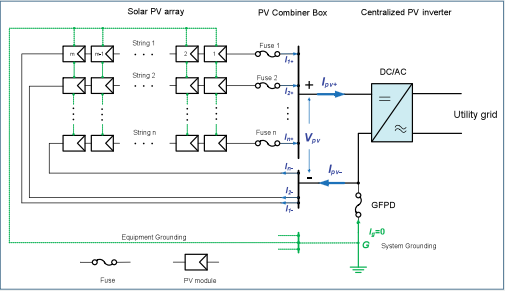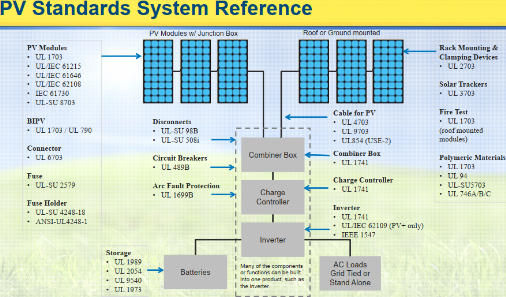PV Panel Grounding: Difference between revisions
Jump to navigation
Jump to search
(→More) |
(→More) |
||
| Line 13: | Line 13: | ||
*Homepower article - 1999 - [https://www.solar-electric.com/lib/wind-sun/PV-Ground.pdf] A '''grounded conductor''' is a conductor that normally carries current and is connected to the earth. Examples are the neutral conductor in AC wiring and the negative conductor inmany DC systems. An '''equipment-grounding conductor''' is a conductor that does | *Homepower article - 1999 - [https://www.solar-electric.com/lib/wind-sun/PV-Ground.pdf] A '''grounded conductor''' is a conductor that normally carries current and is connected to the earth. Examples are the neutral conductor in AC wiring and the negative conductor inmany DC systems. An '''equipment-grounding conductor''' is a conductor that does | ||
not normally carry current (except under fault conditions) and is also connected to earth. A grounding electrode conductor is the conductor between a common single grounding point in the system and the grounding electrode. | not normally carry current (except under fault conditions) and is also connected to earth. A grounding electrode conductor is the conductor between a common single grounding point in the system and the grounding electrode. | ||
[[File:grounding.png]] | |||
=PV Fuses= | =PV Fuses= | ||
Revision as of 01:26, 17 September 2023
NEC 690 - Covers PV Systems
- 690.41 - Equipment Grounding Conductor requirements [1]
- 690.41(B) also requires ground fault protection except if there are no more than 2 strings (PV source circuits [2])
- Since NEC 2020, ground fault indicator must be readily visible (but not necessarily readily accessible?) [3]
- 690.45 - size of PV equipment grounding conductors - Table 250.122 + no less than 14 ga.
- 690.41(B) also requires ground fault protection except if there are no more than 2 strings (PV source circuits [2])
- 690.9(A) says that we don't need overcurrent device for PV if the wires can handle short current capacity of PV. But good luck trying to convince a code official.
 PV Grounding PDF [4]. Although the NEC does not specifically require all equipment to be certified/listed, many local jurisdictions and many AHJs establish requirements that all equipment be certified/listed because they feel unqualified to examine uncertified/unlisted equipment for safety as the NEC requires.
PV Grounding PDF [4]. Although the NEC does not specifically require all equipment to be certified/listed, many local jurisdictions and many AHJs establish requirements that all equipment be certified/listed because they feel unqualified to examine uncertified/unlisted equipment for safety as the NEC requires.
- Good overview doc. Read it from p. 6 on to understand equipment ground, system ground.
- Additional issue for PV is that in cloudy conditions or when there is little sun (evening), if you get a fault, a breaker may not trip because current is too low. For this reason, specific ground fault protection is required. But, if it's a fuse to solid ground from - of PF to ground rod - why not just use a lower value fuse? I don't get it.
- Is earth ground of a PV system connected to DC negative, or to AC neutral?
More
- Homepower article - 1999 - [5] A grounded conductor is a conductor that normally carries current and is connected to the earth. Examples are the neutral conductor in AC wiring and the negative conductor inmany DC systems. An equipment-grounding conductor is a conductor that does
not normally carry current (except under fault conditions) and is also connected to earth. A grounding electrode conductor is the conductor between a common single grounding point in the system and the grounding electrode.
PV Fuses
- Special characteristics: high V (larger strings), more cycling (clouds), high temp, [6]
- Regular fuses do this if: they are high V, they are in a controlled environment, and low cycling
- These conditions are met indoors, with 600V fuses, and low cycling of ground faults (once per lifetime of system). Thus, the solid-ground based ground fault protection fuse can likely be a regular fuse, fast acting preferred.
- Expensive
- Fast acting as long as there are no major inductive loads on the system, otherwise these should be slow-acting because PV panels are voltage and current limited.
- Low fault current acting, high voltage fuses - 0.5 - 1A is fine.
- KLKD $12 - [7]
- DMM 1/2A fuse - [8]
- Fuse rating should bd 1.56*Isc and 1.2x for the voltage [9]
- Standards, p6 - BS alert. PV rating means that a fuse is tested to run at 1.45x the nominal current. Ok, but there is already a 1.56 requirement for these fuse sizes - why another 1.45? [10]
- BS alert: there is 'low leakage current functionality' for pv fuses - but why not just use a smaller fuse rating for lower current?
Ground Faults - System Grounding Howto
- Article says that a common ground fault protection device (GFPD) is a fuse to ground - [11]
- NEC Article 690.41 states that grounding for photovoltaic systems includes 2 grounds [12]:
- The first one is system grounding: the PV system with system voltage over 50 volts should be solidly system-grounded.
- The other one is the equipment grounding: the exposed non-currentcarrying metal parts of PV module frames, electrical equipment, and conductor enclosures should be grounded .
- System Ground Howto: To achieve that, the negative conductor usually is grounded via the GFPD in the PV inverter at point G [13]:
Source: [14]
More
 Solar PV standards and certifications - [15]. Class II means frames grounded, no system ground.
Solar PV standards and certifications - [15]. Class II means frames grounded, no system ground.
 Paper on PV grounding, 1984. Fire safety and personnel safety are typically tradeoffs? [16]
Paper on PV grounding, 1984. Fire safety and personnel safety are typically tradeoffs? [16]
- Solidly grounded means neutral is connected to earth electrode. [17]
- Class II system had double insulation and equipment ground, but no earth connection.
- Class I has equipment ground and earth connection.
- Insulation failures between current-carrying conductors and the ground are known as ground faults.
 Classic video by Mike Holt. Equipment Grounding + system grounding - Ground and grounding electrode conductor basic with Mike Holt - [18]
Classic video by Mike Holt. Equipment Grounding + system grounding - Ground and grounding electrode conductor basic with Mike Holt - [18]
- Do not earth ground frames with a ground rod like this - [19]
Equipment Grounding
- PV panels should follow electrical grounding conductor sizes - [20]
- Ie, for 30A DC, we need 10 ga ground.
- PV frames must be connected to PV system equipment grounding conductor [21]
- After leaving the PV array, the equipment ground must run together with the power wires. [22]
What Size Grounding Conductor on PV Panels?
- Australia rules - appear to say 6 ga for lightning protection, and 12 ga for frame grounding [23]
- 6 ga USA if 'subject to damage'?


